The winner – Mailchimp
Life-changing superhero
In this comparison, Mailchimp wins six out of ten rounds. Two rounds end in a tie, and there are only two aspects where Constant Contact outperforms Mailchimp. Continue reading to learn more.
What Mailchimp features are better than Constant Contact?
- Email campaign editor
- Marketing automation features
- More accurate segmentation
- More analytics
- The email editor isn't bad, but it's just not as good as Mailchimp's.
- Marketing automation may not be sufficient for well-developed ecommerce business
- Very basic segmentation
- Ecommerce data is missing
Constant Contact and Mailchimp have emerged as two prominent players in the marketing space. Both tools provide users with several features to create, manage, and optimize email marketing campaigns.
In this article, we compare Constant Contact vs Mailchimp against different variables, thus providing in-depth insight into what both tools offer.
Let’s get started.
Constant Contact vs Mailchimp: Quick overview
Constant Contact and Mailchimp are highly sought-after platforms that can significantly enhance your email marketing endeavors.
Typically, Constant Contact’s seen as a better fit for email marketing novices. It’s straightforward to use, and its customer support is highly rated. Not to forget the platform’s reporting capabilities and ready-to-send email templates.
On the other hand, Mailchimp is an excellent choice for those who want a massive arsenal of marketing features that go beyond just the basics.
To make the right choice, it’s essential to compare Constant Contact vs Mailchimp carefully.
The following section examines the two platforms’ tools and capabilities.
We’ll explore key features such as email campaign builders, segmentation, user-friendliness, personalization, customer support, and more.
Constant Contact vs Mailchimp comparison: Feature by feature
We have conducted a comprehensive feature comparison between Constant Contact and Mailchimp to help you make the right choice for your business.
Let’s get started.
Ease of getting started
Signing up on both Constant Contact and Mailchimp is pretty straightforward.
All you need to do is provide basic details such as your name, email address, organization name, and website URL.
One of the significant differences between the two is that while Mailchimp’s free trial requires credit card information, Constant Contact doesn’t.
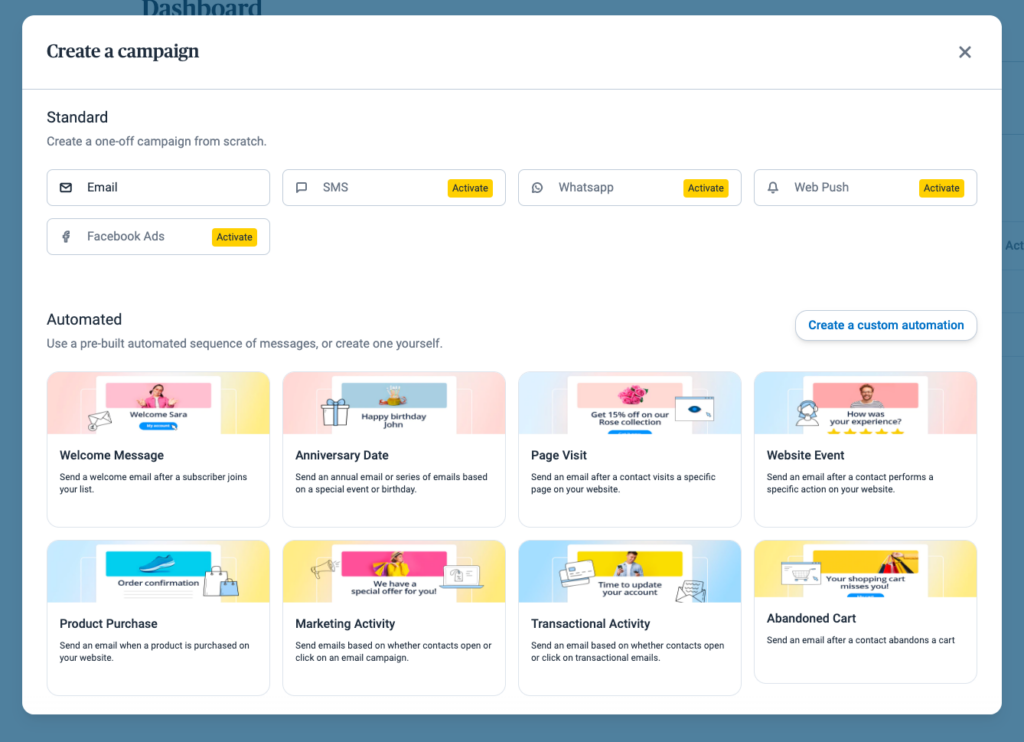
But if you only want to use Mailchimp’s free version, there is no need to provide any payment information. And Constant Contact has an offer of 30-day paid plan refund guarantee.
Regarding navigation, both tools are pretty intuitive and have a clean interface. Whether you choose Constant Contact or Mailchimp, there are many tutorials and checklists to get you started.
However, one problem with Mailchimp is that due to the platform’s extensive features, locating specific functions may be challenging. For instance, removing the Mailchimp logo is a bit complicated.
Constant Contact has a slight edge here. Its initial dashboard helps you start smoothly, and its features are easy to locate.
Building an email campaign
Regarding the ease of building email campaigns, Constant Contact and Mailchimp excel as great tools.
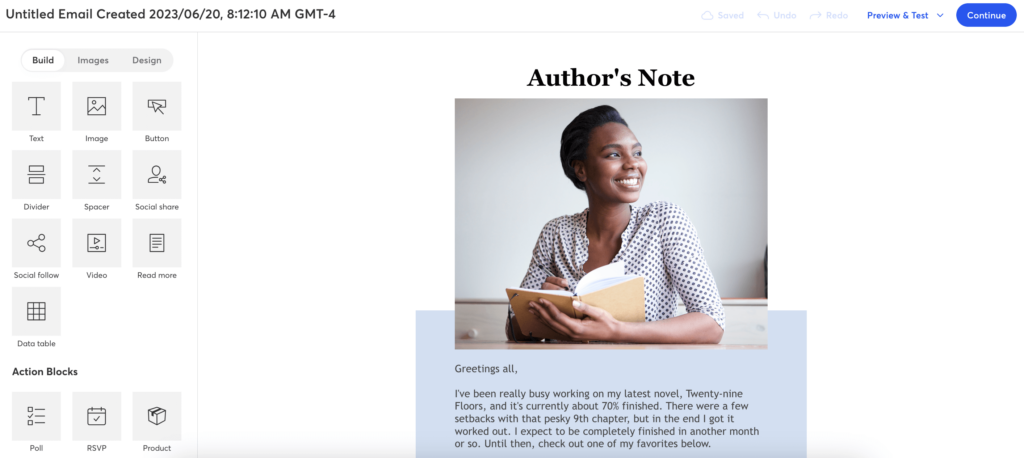
Constant Contact provides an intuitive and user-friendly email builder that simplifies creating email campaigns.
With its drag-and-drop editor, you can easily customize the layout, add images, insert text, and incorporate various elements such as buttons and social media icons.
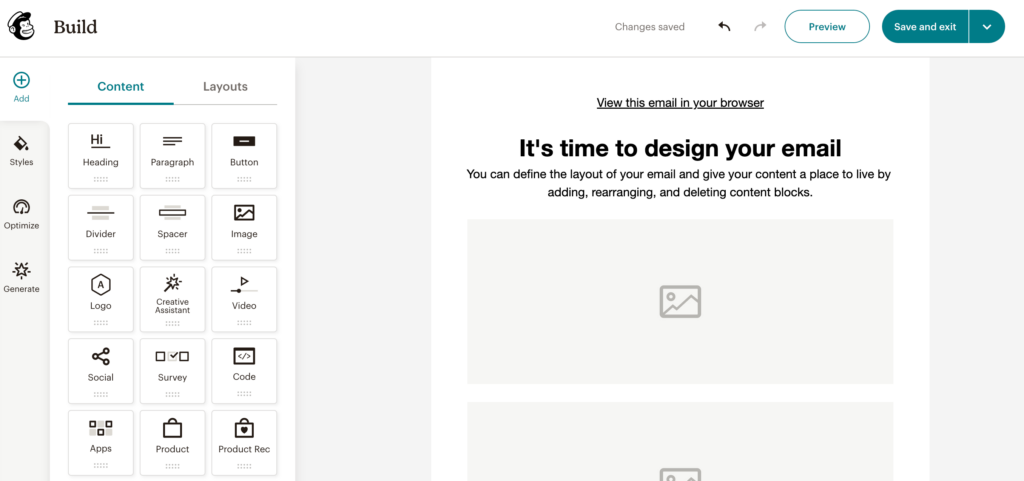
Mailchimp’s email builder is just as powerful. You can easily design and customize your emails without coding skills.
Now, let’s look at other features, such as templates and personalization.
– Hundreds of ready-to-send templates
– Themed templates for different occasions
– Some templates are outdated
– Ability to code your own template
– Modern-looking templates on paid plans
– Six blank templates on the free plan
– Promotional campaigns
– Automated emails
– A/B tests
– Regular campaigns
– Automated emails
– RSS campaigns
– A/B tests
– Option to add contact details to the subject line and email content
– Dynamic links for personalized interaction
– Dynamic content blocks, merge tags, conditional content
– A bit difficult to use without Knowledge Base
BrandKit includes the logo and brand style in emails automatically
If you set up brand assets, such as the logo and brand style, they will adjust in emails automatically.
Talking of limitations, you only get six email templates with Mailchimp’s free plan. And Constant Contact’s product content block doesn’t work smoothly—you have to wait until it synchronizes with your store and shows your products.
Both tools have unique features that can improve your email campaigns.
Mailchimp provides integration with Litmus, offering 25 tokens of inbox preview. Constant Contact offers coupon content blocks which are pretty helpful for ecommerce businesses.
Mailchimp wins. Its new email builder beats Constant Contact’s sophistication and user-friendliness.
Marketing automation
As your business grows, automation becomes crucial to handle larger volumes of leads and customers.
So, which one fares better in this regard, Mailchimp or Constant Contact?
Let’s compare.
– Single-step as well as multi-step automation
– Automated path builder with several templates
– Automation builder with powerful segmenting, scheduling, and design tools
– Ability to send triggered emails based on specific events or actions
– Option to add SMS by paying extra
– SMS
– 15 suggested templates for different scenarios
– Comes with logic and suggested copy
– 70+ pre-built customer journey templates
– Only comes with structure; no content
– Yes, the option to view queued contacts, sent emails, open and click rates, revenue, conversion rates, etc.
– Classic Automation Reports for campaign stats, including status and queue numbers
– Ecommerce metrics
– Ability to view statistics for deleted automation emails
Note that neither of the tools allows you to add A/B test splits to the automation workflow.
We found that Constant Contact’s automation capabilities aren’t as robust as many of its competitors. They’re only good enough for small businesses that require straightforward automation workflows.
Mailchimp. Its automation features suit businesses of all sizes, especially those looking for advanced automation features and customization options.
Signup forms and landing pages
The success of your marketing and lead generation efforts heavily depends on the availability of signup forms and landing pages.
In this section, we’ll examine the list-building features of Constant Contact vs Mailchimp.
– No pre-built templates
– One basic form design customizable as per your brand style
– GDPR-compliant
– No pre-built templates
– Easy to create forms matching your brand aesthetic
– GDPR-compliant
– Yes, landing page builder with a drag-and-drop editor
– No templates
– Yes, comprehensive landing page builder and 9 templates
– Can be used to offer exclusive content, discounts, or incentives
– Easy importing of customer database
– Contact segmentation based on specific criteria, tags
– Tools to manage bounced emails, unsubscribe requests, and inactive subscribers
– Easily tag and segment subscribers
– Lists are siloed; need to pay for duplicate and unsubscribed contacts
An exciting feature of Constant Contact is the ability to generate a QR code and direct users to your sign-up form.
Constant Contact and Mailchimp offer a range of signup form options, allowing you to select from popups, flyouts, inline forms, banners, etc.
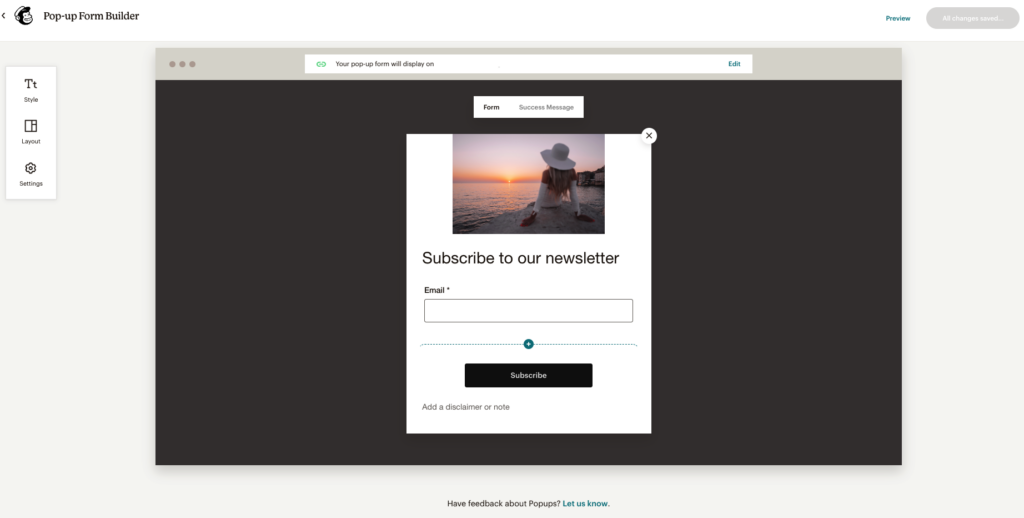
But neither of the tools comes with pre-built templates, which slows down the list-building process.
You can, however, analyze the performance of your signup forms. On both platforms, you can view the number of submissions, conversion rates, and other metrics.
It’s a tie. Although Mailchimp has better features, the siloed contact lists can be a pain when growing your contacts and maintaining your email marketing bill. Constant Contact is better in this regard but doesn’t have landing page templates.
Segmentation
Next, let’s compare Constant Contact vs Mailchimp in their segmentation capabilities.

Constant Contact comes with four pre-built segments based on customer engagement levels.
- Most engaged
- Somewhat engaged
- Least engaged
- Everyone else
However, this segmentation is pretty basic and doesn’t say anything specific about your subscribers. Some ecommerce and customer behavior aspects exist to segment your audience, for example, list membership, contact details, tags, contact email activity, ecommerce activity (placed an order, amount spent, number of orders, etc). But they’re not as comprehensive as other advanced tools in the market.
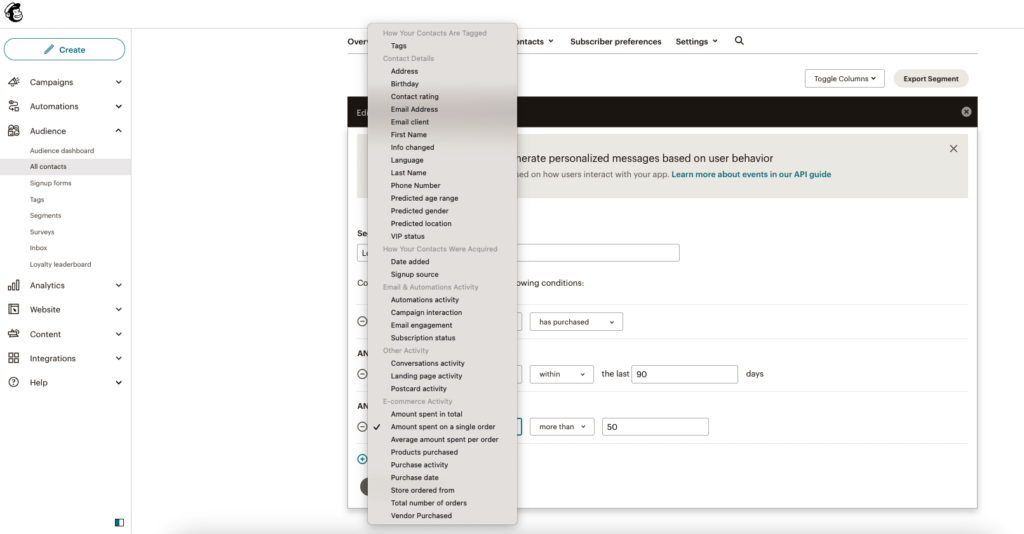
On the other hand, Mailchimp offers three pre-build segments and an extended list of criteria to segment your audience in multiple ways.
When building from scratch, you can add up to five conditions for each segment. Mailchimp also provides advanced capabilities tailored for ecommerce businesses.
You can segment your contacts based on their purchase history, order value, or specific product categories. This enables you to implement highly targeted marketing strategies for maximum effectiveness.
Mailchimp wins again. It offers greater flexibility and customization options, although it may require a slightly higher learning curve to utilize its capabilities thoroughly.
Analytics
Analytics plays a pivotal role in providing the necessary insights for informed decision-making.
So which one is right for the job — Constant Contact or Mailchimp? Let’s compare:
– Yes, insights into the overall performance of email campaigns and separate campaigns
– Bar charts for easy-to-digest statistics
– Click-tracking heatmaps to see which links got the most clicks
– Mobile app for on-the-go tracking
– Data on crucial metrics concerning email performance, audience insights, and ecommerce activity
– List-wide or campaign-specific graphs
– Click map
– Mobile app for report tracking
– None
– Comparative reporting to compare the performance of different email campaigns or segments
– Content Optimizer for recommendations based on best industry practices
One drawback of Mailchimp is that most advanced reporting features, such as comparative analysis, multivariate testing, or advanced segmentation, are only available in higher-tiered plans.
As for Constant Contact, ecommerce data for email campaigns is missing.
Mailchimp wins again. This is simply because it offers far more features, including ecommerce-related analytics, and more advanced ones, such as Content Optimizer and comparative analysis.
Customer support
Having assistance readily available when needed is a significant consideration.
It’s a factor that can make or break a decision for many users, and understandably so.
Constant Contact truly shines in this round. Here’s why:
- The platform offers phone, live chat, as well as email support
- High-tier plan users can opt for onboarding calls
- A wide variety of resources, including webinars, blog posts, video tutorials, and more
However, one drawback is that support is only available on working days.
Now, let’s talk about Mailchimp’s customer service.
When users initially seek support, Mailchimp encourages looking at its Help Center. This is because the tool’s articles and tutorials answer most, if not all, questions.
Mailchimp offers round-the-clock email support if you need further assistance, ensuring assistance is available at any time. Additionally, there is live chat support on weekdays.
For free plan users, email support is available for the initial 30 days.
Constant Contact wins this one. It surpasses expectations when it comes to customer service, going the extra mile to provide exceptional support.
Integrations
Robust integration capabilities eliminate the hassle of switching between multiple platforms, ensuring a seamless and efficient workflow.
Constant Contact allows over 300 integrations with all sorts of tools and software. They fall under several categories: ecommerce, social media, event management, and analytics.
The best part?
You’ll have access to these integrations no matter which plan you choose.
Similarly, Mailchimp also provides 300+ integrations filtered by category. These can be integrated effortlessly and at no cost with just a few simple clicks.
In this round, both tools win. The number and kind of integrations offered are pretty similar.
Compatibility with other marketing channels
Before we move on to pricing, let’s look at both tools’ compatibility with other marketing channels.
Mailchimp allows you to incorporate SMS, Facebook and Instagram into your marketing strategy while offering compatibility with Google Analytics.
Constant Contact offers the option to access SMS marketing as an add-on feature. However, this is only available to users based in the United States.
Moreover, it’s compatible with Instagram, LinkedIn, Twitter accounts, and Google and Facebook ads.
Since launching SMS marketing, Mailchimp has clearly become a leader in compatibility with other channels.
Price Comparison
The determining factor in selecting an email marketing platform is frequently the pricing.
It’s crucial to verify that the cost you are paying corresponds to the value you are receiving. Let’s determine which tool is more cost-effective for your business.
Constant Contact doesn’t offer a free plan; you can opt for its 14-day free trial.
On the other hand, Mailchimp does offer a free plan. Although it has a limit of 500 contacts and 1,000 monthly emails, you get access to a decent set of features. Here are some of them:
Free plans comparison
- No free plan. 14-day free trial with access to limited features
- Basic segmentation
- Audience dashboard
- Surveys and pop-up forms
- Landing pages
- Facebook and Instagram ads
- Basic analytics
- Personalized product recommendations
- Email support for the first 30 days
Mailchimp offers a 30-day free trial for both the Essentials and Standard plans if you wish to test the waters before committing.
Take a look at the comparison table to see what you can expect when growing your list on both platforms.
Paid plan comparison
Regardless of whether you choose Constant Contact or Mailchimp, your price will predominantly be based on the size of your subscriber list and features you need.
The table above makes it clear that Mailchimp’s pricing, except for the Premium plan, is more affordable. If you consider the functionalities, the lowest-tier plans are very limited and you most probably will need Standard plan offers. So comparing these two plans, Mailchimp’s features are a lot more advanced and sophisticated.
Compared to other tools in the market, though, Constant Contact and Mailchimp Premium are especially expensive if you have extensive subscriber lists.
Summary: Which one wins?
To recap everything covered in the article, here’s a summary:
4
4.5
500 subscribers – $12
1,000 subscribers – $30
5,000 subscribers – $80
10,000 subscribers – $120
50,000 subscribers – $430
100,000 subscribers – custom price
500 subscribers – $13
1,000 subscribers – $13
5,000 subscribers – $75
10,000 subscribers – $110
50,000 subscribers – $385
– Paid plans only
– 14-day free trial
– Most paid features except email templates, email campaign scheduling, multivariate testing, advanced segmentation, comparative reporting
– 1,000 email sends/mo
– Email support for 30 days
– Easy to get started
– Good customer support
– Great compatibility with other marketing channels
– Lots of integrations and can be easily integrated into any toolkit
– Wide range of features and analytics
– Lots of integrations and can be easily integrated into any toolkit
– Basic signup forms and landing pages
– Basic reporting
– Design limitations while building email campaigns
– Charges for email duplicates – if you have the same subscriber in two different lists, you pay extra
– Paid plans get very expensive as the subscriber list grows
– Basic email templates on the free plan
– Ecommerce beginners
– Non-profit organizations
– Solopreneurs
– Startups
– Bloggers
– Non-profit organizations
– Well-established ecommerce businesses
– Lifestyle bloggers
– Ecommerce stores in their active growth stage
Each email marketing solution comes with its strengths and weaknesses.
Constant Contact is a user-friendly and affordable platform, making it an excellent choice for beginners with basic email marketing needs. However, the pricing may not align well with the budgets of small businesses.
On the other hand, if you require more advanced features, Mailchimp is a recommended option.
Nevertheless, it’s important to note that there are exceptional alternatives to Constant Contact and Mailchimp.
By carefully assessing your specific requirements and budget, you can determine your business’s most suitable email marketing platform.
Related picks for you
Our team strives to be accurate and unbiased in reviewing email tools. However, we recognize that mistakes can happen, and it’s essential for us to stay up to date. If you come across any errors or things that need to be reviewed again, please let us know.


Leave a Reply